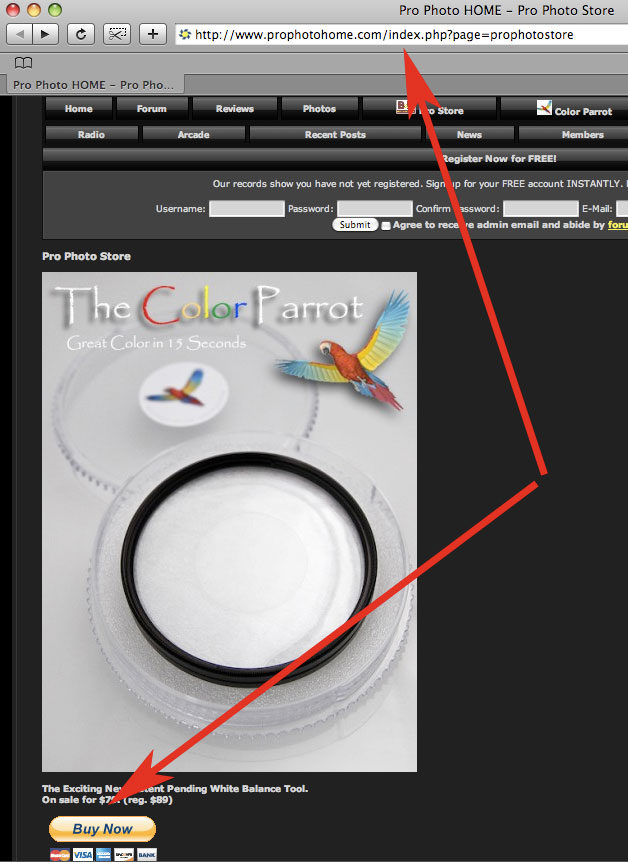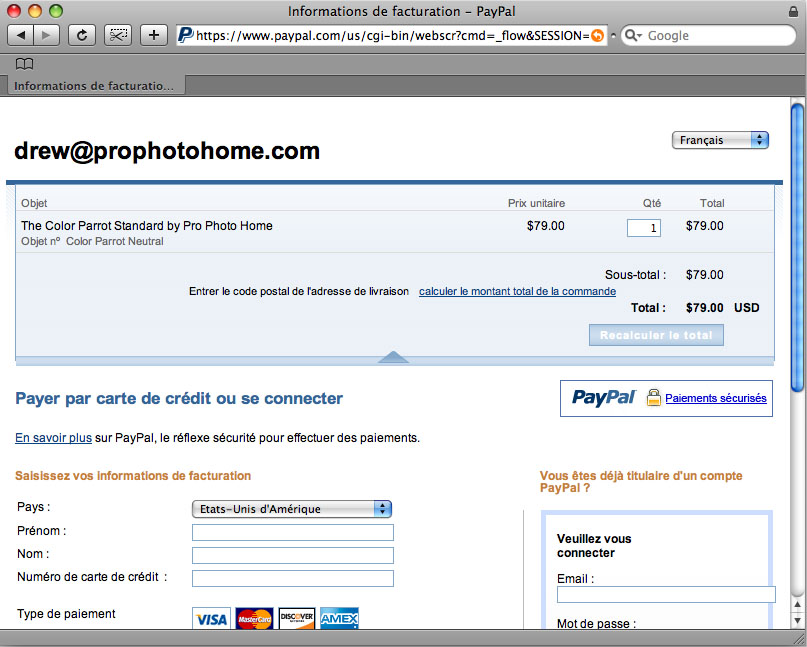Doug Kerr
Well-known member
New measurements, or, "Certain Death Averted"
Drew has pointed out a "fatal flaw" in my initial report on the behavior of the Color Parrot, in that (he said) I operated on the assumption that my WhiBal gray card was perfectly neutral.
I didn't say that. I said it was very close to neutral based on credible statements from the manufacturer as to the limits on neutrality error. Thus I would use it as a refernce, but we all needed to be mindful of a small uncertainty introduced by my not knowing its exact reflective chromaticity.
But in the interest of overcoming this death warrant, I have acquired a "pedigreed" WhiBal gray card - one which the manufacturer was kind enough to measure precisely for me
I've also developed a workflow that lets me determine the recorded color of the light through the diffuser, as captured by the camera, not by reading R, G, and B on an 8-bit basis but rather on a 15-bit basis. (That's what the Photoshop "16-bit RGB" reading of the colors represented in a 16-bit TIFF file actually gives!)
Doing this greatly reduces a major source of potential experimental error we had in the prior situation (with RGB quantizing error giving a possible uncertainty of perhaps 0.001 unit of du'v').
So, what's a guy with new toys to do but make some more measurements with them. So I decided to rerun my basic determination of the transmissive chromatic neutrality of my v 0.1 Color Parrot.
And the Easter Bunny also brought me a 2007 model Expo Disc (the one I had was the 2006 model, albeit just recently bought from B&H). So I thought I would include it in this new run for comparison (since we hear a lot about it in discussions of the Color Parrot).
As before, the test were run using a Canon EOS 20D with a Canon EF 24-105 mm f4.0 IS lens. The diffuser shots were taken at a focal length of 24 mm at f/4, with focus at infinity. Exposure was metered, with an EC of +1.0 stop.
The tests were run, as in many prior cases, with "daylight filtered through a white venetian blind" in our breakfast room as the source.
Let me note that, since I have not yet made specific tests on the variation (if any) of the chromatic response of the Color Parrot with angle of incidence, I can't be sure that this particular test lighting setup would give the same result as with some other lighting setup.
In any case, without further ado, here are the test results:

Note that here the chromaticity of the WhiBal gray card is plotted at the values stated by the manufacturer, and the other values are plotted with reference to that. The intent is that their actual response is properly plotted on the chart.
On a related front, we also determined the relative transmission of the two diffusers (as before' based on the camera's metering system readings, in terms of Measured BV, as reported in the makernote, read with ExifTool. It seems that the Color Parrot is about 0.87 stops "hotter" than the Color Parrot for this particular arbitrary angular distribution of the incident light (directivity pattern considerations could well lead to a different comparison for other light source configurations).
This is close to the value noted by Drew ("about twice").
Best regards,
Doug
Drew has pointed out a "fatal flaw" in my initial report on the behavior of the Color Parrot, in that (he said) I operated on the assumption that my WhiBal gray card was perfectly neutral.
I didn't say that. I said it was very close to neutral based on credible statements from the manufacturer as to the limits on neutrality error. Thus I would use it as a refernce, but we all needed to be mindful of a small uncertainty introduced by my not knowing its exact reflective chromaticity.
But in the interest of overcoming this death warrant, I have acquired a "pedigreed" WhiBal gray card - one which the manufacturer was kind enough to measure precisely for me
I've also developed a workflow that lets me determine the recorded color of the light through the diffuser, as captured by the camera, not by reading R, G, and B on an 8-bit basis but rather on a 15-bit basis. (That's what the Photoshop "16-bit RGB" reading of the colors represented in a 16-bit TIFF file actually gives!)
Doing this greatly reduces a major source of potential experimental error we had in the prior situation (with RGB quantizing error giving a possible uncertainty of perhaps 0.001 unit of du'v').
So, what's a guy with new toys to do but make some more measurements with them. So I decided to rerun my basic determination of the transmissive chromatic neutrality of my v 0.1 Color Parrot.
And the Easter Bunny also brought me a 2007 model Expo Disc (the one I had was the 2006 model, albeit just recently bought from B&H). So I thought I would include it in this new run for comparison (since we hear a lot about it in discussions of the Color Parrot).
As before, the test were run using a Canon EOS 20D with a Canon EF 24-105 mm f4.0 IS lens. The diffuser shots were taken at a focal length of 24 mm at f/4, with focus at infinity. Exposure was metered, with an EC of +1.0 stop.
The tests were run, as in many prior cases, with "daylight filtered through a white venetian blind" in our breakfast room as the source.
Let me note that, since I have not yet made specific tests on the variation (if any) of the chromatic response of the Color Parrot with angle of incidence, I can't be sure that this particular test lighting setup would give the same result as with some other lighting setup.
In any case, without further ado, here are the test results:

Note that here the chromaticity of the WhiBal gray card is plotted at the values stated by the manufacturer, and the other values are plotted with reference to that. The intent is that their actual response is properly plotted on the chart.
On a related front, we also determined the relative transmission of the two diffusers (as before' based on the camera's metering system readings, in terms of Measured BV, as reported in the makernote, read with ExifTool. It seems that the Color Parrot is about 0.87 stops "hotter" than the Color Parrot for this particular arbitrary angular distribution of the incident light (directivity pattern considerations could well lead to a different comparison for other light source configurations).
This is close to the value noted by Drew ("about twice").
Best regards,
Doug


